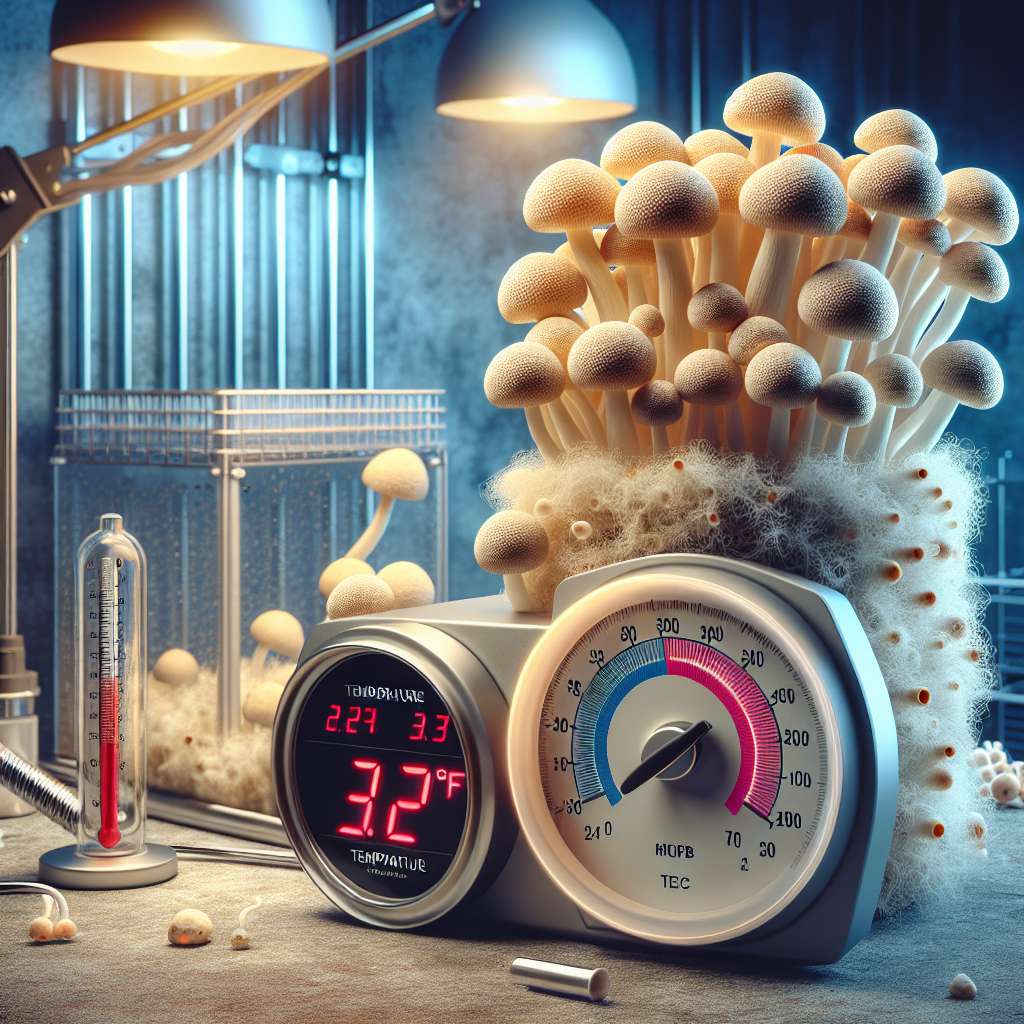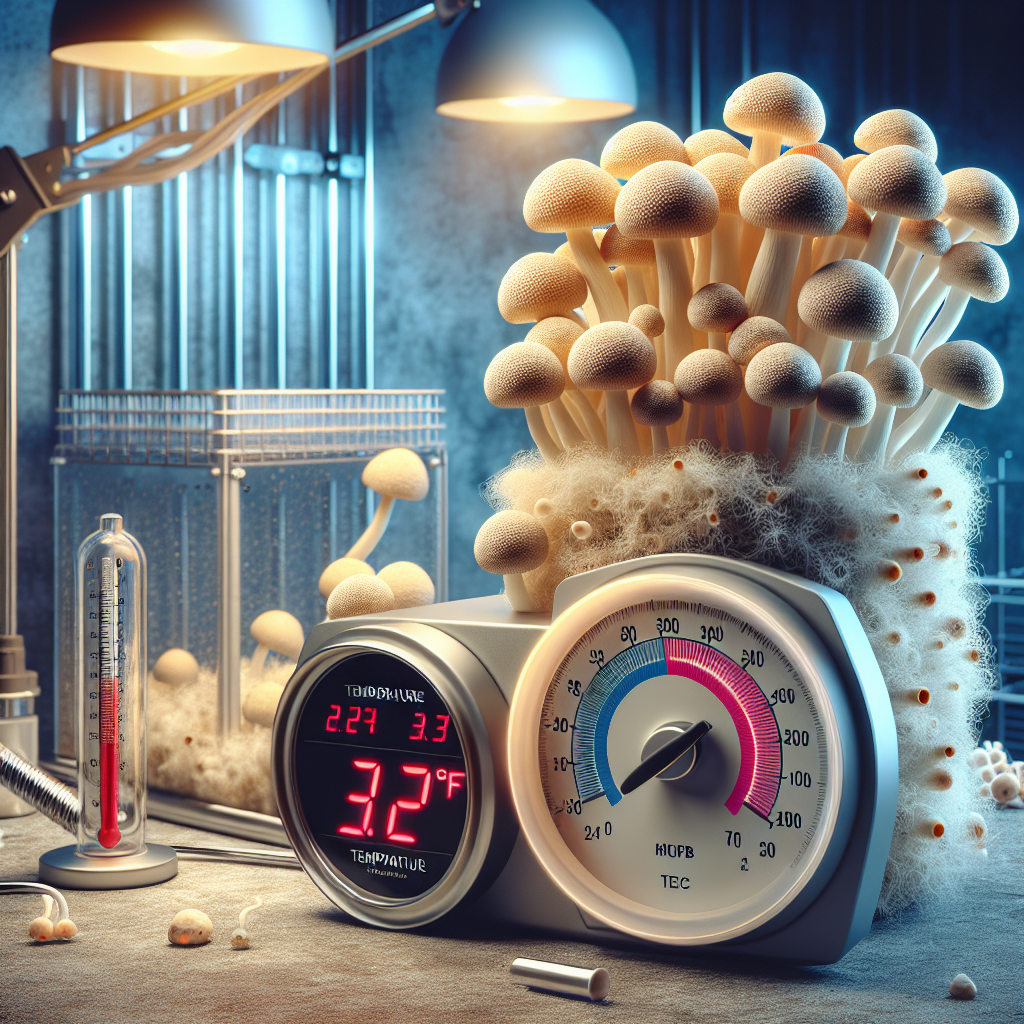In the comprehensive article, “Understanding the Ideal Temperature for Mycelium Growth”, you will explore pivotal research and findings concerning the pivotal environmental factors that influence mycelium development. As a crucial driver in the field of mycotechnology, the determination of optimum temperatures forms the foundation of successful mycelium cultivation. By comprehending the nuances of these factors, you can significantly improve your knowledge in mycological science, and enhance the growth potential of your mycelium cultures for innovative industrial applications.

Understanding Mycelium
Mycelium represents a vital component of the ecosystem, playing a critical role in nutrient cycling, decomposition and organic matter turnover. They are an often underappreciated part of the fungal community, but are fundamental to many biological processes.
Defining Mycelium
Mycelium is the vegetative part of a fungus, consisting of a complex network of filamentous cells known as hyphae. It’s akin to the roots of a plant, drawing nutrients from the environment and transporting them to where they’re needed. Hyphae grow by branching and elongating, ultimately forming the intricate webs that make up a mycelial network.
The Role of Mycelium in Nature
In nature, mycelia have a key function in the decomposition of organic material, breaking down dead and decaying organic matter and releasing nutrients back into the soil. It aids in nutrient cycling and improves the fertility and water retention of soil. Furthermore, some mycelia form mutualistic relationships with plant roots, known as mycorrhizal associations, in which the mycelium exchanges soil nutrients for plant sugars.
Mycelium and Fungi: An Inseparable Relationship
Mycelium and fungi share an inseparable association. Fungi are macroorganisms that we can see with the naked eye, while mycelium represents its nearly invisible microscopic underpinning. It forms the basis for fungi, providing the structure and the capacity to absorb nutrients. Without mycelium, fungi would be unable to thrive.
Ideal Temperature for Mycelium Growth
The conditions under which mycelium thrive are of considerable interest, particularly for those seeking to actively cultivate these organisms. One such condition of critical importance is temperature.
The Importance of Temperature in Mycelium Growth
Temperature is a crucial factor in mycelium growth. It influences the rates of cellular metabolic processes and enzyme activities and is therefore of prime importance for the growth and reproduction of mycelium and fungi. Each mycelial species has a specific temperature range within which it can grow, a minimum and maximum temperature threshold beyond which growth is arrested, and an optimum temperature at which growth is maximized.
Defining the Ideal Temperature
The ideal temperature for mycelium growth primarily depends on the specific species. However, most mycelium species prosper in temperatures approximating 24-27 degrees Celsius (75-80 degrees Fahrenheit). It is at this temperature range that the cellular processes and enzymatic activities function most optimally.
Understanding Temperature Variations
Temperature variations out of the optimal range can cause different degrees of stress to the mycelium, potentially culminating in reduced growth and productivity. Persistently high temperatures may lead to denaturation of vital proteins and enzymes, while very low temperatures can significantly slow down metabolism and enzymatic reactions, stalling growth.
Influence of Temperature on Mycelium Activity
Temperature profoundly influences mycelial activity, having direct effects on the expansion, nutrient uptake, and overall metabolism of this organism.
Impact on Mycelial Expansion
Higher temperatures within the tolerable range elevate the metabolic activity of mycelium, facilitating faster growth and more extensive mycelial expansion. Conversely, temperatures below the optimal range slow this process down.
Effect on Nutrient Uptake
Mycelium absorbs nutrients from its surroundings to sustain its growth. This process is directly influenced by temperature; higher temperatures increase the permeability of the hyphal cells, improving nutrient uptake, while lower temperatures decrease it.
Influence on Fungal Metabolism
The metabolic rate of mycelium, like most organisms, increases with temperature within a tolerable range. Metabolic processes become slow and inefficient at low temperatures, and excessive heat can denature proteins and enzymes, disrupting normal metabolic function.
Factors Affecting Ideal Growth Temperature
Several factors can influence what constitutes an ‘ideal’ growth temperature for mycelium.
Species Variety and their Temperature Preferences
Different species of mycelium have different temperature preferences. Some species thrive in cool environments, some prefer moderate temperatures, and others require warmer conditions.
Temperature Interactions with other Environmental Factors
Temperature does not act in isolation. Its influence on mycelial growth can be affected by its interaction with other environmental factors, such as humidity, light, and CO2 levels, among others. For instance, high humidity levels can mitigate the effects of high temperatures.
Impact of Geographic Location on Temperature Preference
Geographic location and the associated climates undoubtedly shape the temperature preferences of different mycelium species. Those originating from tropical regions are more likely to prefer warmer temperatures, while those from temperate regions may prefer cooler conditions.

Effects of Temperature Extremes on Mycelium
Understanding how extremes of temperature affect mycelium is crucial, particularly in the context of our changing climate.
Effects of Temperatures Below Ideal Range
Temperature falling below the acceptable range may cause mycelium to enter a dormant state, effectively halting growth. The pace of enzymatic activity tends to slow down, resulting in a slower rate of nutrient absorption and overall reduced metabolic activity.
Effects of Temperatures Above Ideal Range
Exposure to temperatures above the upper threshold can be damaging or even lethal to mycelium. High temperatures may result in the denaturation of essential proteins, enzymatic inhibition, and the disruption of cellular structures, potentially leading to the death of the organism.
How Mycelium Respond to Temperature Stress
Mycelium has developed adaptive responses to manage temperature stress. Clamp connections, for example, form at the septa of hyphae restricting the movement of organelles and nucleoplasm when exposed to high temperatures. Some species produce heat-shock proteins which protect other proteins from damage caused by temperature extremes.
Regulating Temperature for Mycelium Cultivation
Cultivating mycelium, whether for culinary, medicinal, or ecological purposes, requires careful control of environmental conditions.
Tools for Temperature Control
Modern mycologists have a range of tools at their disposal to control the growing environment’s temperature. These include climate-controlled grow rooms, heat mats, and thermostatically controlled heaters.
Room/Vessel Temperature vs Substrate Temperature
While controlling the ambient temperature in the grow room/vessel is important, it is the substrate temperature that directly impacts mycelium growth since it is in the substrate that the mycelium is growing.
Troubleshooting Temperature Issues
Signs of temperature-related growth issues include slow or stunted growth, or a growth pattern that deviates from the norm. These problems may be addressed by adjusting the cultivation environment’s temperature.
Impact of Temperature on Mycelium Productivity
Temperature’s Role in Fruit Body Formation
The formation of fruit bodies, the part of the organism traditionally used for culinary purposes, is highly dependent on temperature. A drop-in temperature often acts as a trigger for initiating the fruiting process.
Temperature and Mycelium Biomass Accumulation
Temperature also significantly impacts mycelium biomass accumulation. Optimal temperatures result in higher overall growth rates, leading to an increased accumulation of biomass.
Influence of Temperature on Secondary Metabolite Production
Many mycelium species produce secondary metabolites with potential therapeutic properties. The production of these metabolites is heavily influenced by temperature, with many species producing the highest amount of these metabolites at their optimal growth temperatures.
The Role of Fluctuating Temperatures in Mycelium Growth
Temperature in a natural environment is rarely constant. Consequently, mycelium has evolved to deal with fluctuating temperatures.
Impact of Diurnal Temperature Changes
Fluctuations in temperature over the course of the day, known as diurnal temperature variation, can impact mycelium growth. Many species have adapted to the typical diurnal patterns of their environment, showing increased growth rates during the part of the day with the most favorable temperatures.
Role of Seasonal Temperature Shifts
Seasonal shifts in temperature also influence mycelium growth. Many species have distinct growing seasons that align with the times of the year when the temperature is within their ideal range.
Adaptive Mechanisms in Response to Fluctuating Temperatures
Mycelium has various adaptive strategies in response to fluctuating temperatures. For instance, some species alter their metabolic processes to better cope with sub-optimal temperatures temporarily.
Critical Temperature Values for Various Mycelium Types
Ideal Temperatures for Common Edible Mushrooms
Edible mushrooms have distinct temperature preferences for optimum mycelium growth, fruiting, and sporulation. Example, Agaricus bisporus, also known as Button mushrooms, prefers temperatures between 20-24°C for mycelial growth and fruiting.
Ideal Temperatures for Medicinal Mushrooms
Similarly, medicinal mushrooms also have their own unique temperature preferences. For instance, Ganoderma lucidum, commonly referred to as Reishi, grows best mycelial-wise in the range of 24-28°C.
Temperature Ranges for Wild Fungal Species
Temperature preferences for wild fungal species vary widely, and rather than a ‘universal’ ideal range, these species have preferences shaped by their native climates and environments.
Future Research in Temperature and Mycelium Growth
Unanswered Questions About Temperature and Mycelium
Many unanswered questions remain regarding the complexity of temperature’s influence on mycelium growth. This is a pursuable research area that could shed light on the intricate effects of temperature on cellular and molecular levels within mycelium.
Potential Use of Genetically Engineered Mycelium
The advent of genetic engineering presents exciting new possibilities for mycology. Genetically engineered strains could potentially be created with optimal temperatures that better fit human requirements, expanding their agricultural, culinary, and medicinal uses.
Developing Climate-Resilient Mycelium Strains
Climate resilience is an increasingly important consideration, given the expected impacts of climate change on global temperatures. The cultivation of strains adapted to a wider temperature range could contribute significantly to our ability to grow food and medicines sustainably, and maintain ecosystem health in the face of changing climate conditions.
